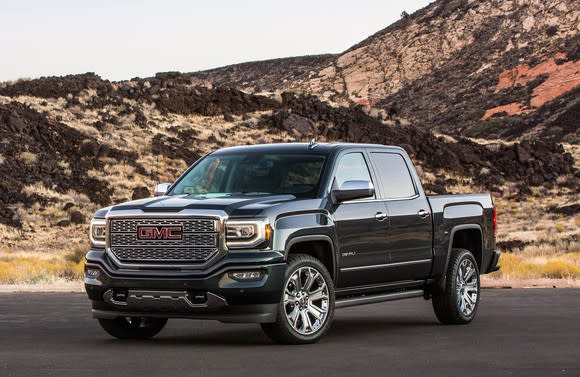Why General Motors' 4.4% Dividend Yield Is a Good Bet
General Motors (NYSE: GM) has made a lot of news lately, and it's not the kind that automakers like to make. Late last month, GM announced that it plans to idle five factories and cut 15% of its salaried workforce as part of a major restructuring of its operations in North America.
Nobody likes to hear that factories are being closed, particularly effected workers and the politicians who represent them. GM's announcement led to something of an uproar -- and to some hard questions: Is GM in trouble? Is a dividend cut likely?
That latter question isn't trivial. GM's 4.4% dividend yield has drawn considerable interest from investors -- but high dividend yields are only interesting if they're sustainable.
Is GM's dividend sustainable? Let's take a look.

CEO Mary Barra has GM prepared to pay its regular quarterly dividend through a recession. Image source: General Motors.
General Motors' dividend: Key stats
Metric | GM |
|---|---|
Current quarterly dividend per share | $0.38 |
Current dividend yield | 4.4% |
Payout ratio | 28.3% |
Last increase | February 2016 |
Data source: General Motors. Payout ratio is through the first three quarters of 2018. "Last increase" is the date the increase was officially declared, not the date it was first paid.
GM's payout ratio is fairly conservative, not a worry. But its dividend yield is 4.4%, well above average. Anytime we see a dividend yield over 3%, it's important to dig deeper, as it raises some important questions that need to be answered before we invest.
How to tell if a high yield is a buy signal or a warning sign
Here's the first question: Is GM's yield high because the stock's valuation is lower than it should be? And if so, why is the valuation low?
A low valuation can be a value-investing opportunity, a chance to buy a company that the market is overlooking. But it can also mean that investors are staying away from the stock for good reasons.
Right now, GM is trading at just over 5 times its adjusted earnings per share ($6.76) over the last four quarters. Here's how that compares with the price-to-earnings ratios of GM's key global competitors.
Company | P/E Ratio |
|---|---|
BMW | 5.6 |
Daimler | 5.5 |
Fiat Chrysler Automobiles | 6.6 |
Ford | 5.5 |
Honda | 4.7 |
Toyota | 7.6 |
Data source: Thomson Reuters.
GM's valuation is toward the lower end of the group's range, but it's not out of line with most of its rivals'. Most of the global automakers are trading at fairly low valuations right now, a sign that the market expects the pace of auto sales to decline over the next several quarters.
Is GM's dividend sustainable through a downturn?
The second question is whether GM will be able to sustain its dividend payments at the current level. Is the company paying out more than it will be able to afford over time?
That's an especially important question given the market's expectation that auto sales are set to decline. Automakers are cyclical businesses; we know from history that their profits will decline (or disappear entirely) during a recession. They have high fixed costs and require a fairly high level of sales just to break even. GM is far above its break-even point right now, but when sales decline during a recession, its profits will almost certainly decline as well.

Luxury trucks like the GMC Sierra Denali have helped keep GM's margin high. But sales of such trucks will slow during a recession, squeezing GM's profits. Image source: General Motors.
In the past, automakers have not only cut dividends during recessions, they have also been forced to cut spending on future programs, which left them with dated products in their dealers' showrooms when buyers returned in the early stages of the post-recession recovery.
Nowadays, most automakers, including GM, maintain a hefty cash reserve, backed by a revolving line of credit, to ensure that they can keep funding future products through a downturn. As of the end of the third quarter, GM had $18 billion in cash, and another $14.1 billion in available credit lines -- an ample reserve for a moderate-to-steep recession.
What does that have to do with GM's dividend? Everything: GM has said repeatedly that it will continue to pay its quarterly dividend at the current level through a recession until that cash reserve is gone. In other words, the point at which GM will cut its dividend in a recession is the point at which it's forced to begin tapping its line of credit.
GM said last year that it has modeled a typical moderate recession and concluded that it would use about $5 billion from its cash reserve in the first year of the downturn. Of note: Over the last 45 years, peak-to-trough economic contractions in the U.S. have lasted an average of 12 months.
So while a recession that is both severe and protracted could force GM to cut its dividend (along with lots of other things), it is well prepared to continue paying its dividend at the current level through a "typical" recession -- and maybe even through a fairly severe one.
Why GM's restructuring might be a good sign for dividend investors
Finally, let's address the questions raised by GM's restructuring plan. I don't think GM is "in trouble" now, and I don't think a dividend cut is likely. I think that CEO Mary Barra is being proactive, battening down GM's hatches before the next economic storm hits, so that the company isn't forced to cut its investments in crucial new products and technologies to stay afloat.
In fact, I think this restructuring might make it easier for GM to sustain its dividend through a downturn. CFO Dhivya Suryadevara said that she expects the restructuring to boost GM's adjusted automotive free cash flow by $6 billion a year by 2020. She also expects the changes to lower GM's break-even point, the level of annual sales at which it would swing from profits to losses in a recession.
Suryadevara promised more specifics in January at GM's annual investor briefing. But there's no reason to think that GM's dividend is now at risk -- and some reasons to think that the risk of a dividend cut is lower than it has been in a while.
More From The Motley Fool
John Rosevear owns shares of Ford and General Motors. The Motley Fool recommends BMW and Ford. The Motley Fool has a disclosure policy.
